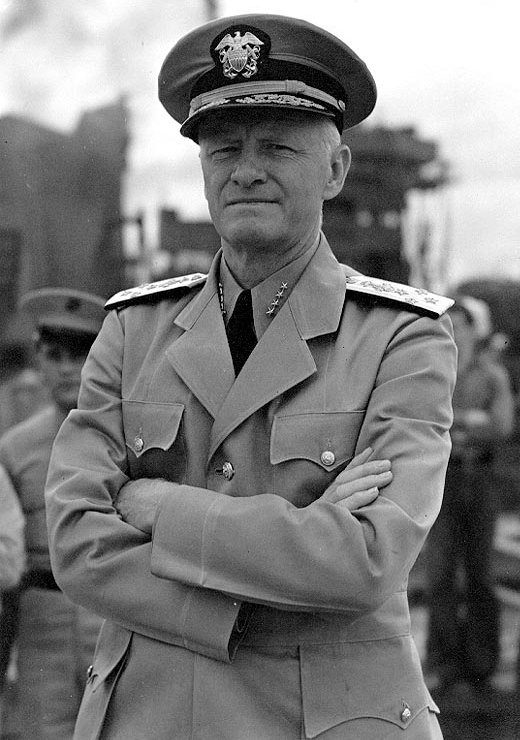Chester W. Nimitz (1885-1966) was Fleet Admiral of the US Navy and Commander in Chief of the US Pacific Fleet during World War II.
Nimitz was born on February 24, 1885 in Fredericksburg, Texas to parents of German descent. He attended the US Naval Academy from 1901-1905, where he finished 7th in his class of 114 officers. Before World War I, he studied engines in Germany and Belgium. He conducted experiments in the refueling and energy efficiency of large ships.
WORLD WAR II
When the attack on Pearl Harbor occurred, Nimitz had been in the US Navy for 30 years. He was ranked a Rear Admiral and stationed in Washington, DC as chief of the Bureau of Navigation.
10 days after the attack on Pearl Harbor, President Roosevelt promoted Nimitz to commander-in-chief of the United States Pacific Fleet as an Admiral. The rank of vice admiral was skipped by congressional appointment. Nimitz had operational control over all allied units in the Pacific, including air, land, and sea forces. Under his leadership, the United States stopped the further advance of the Japanese after Pearl Harbor and organized a sharp offensive response across a massive geographic area. In December 1944, President Roosevelt appointed Nimitz Fleet Admiral. This is a lifetime appointment.
KNOWLEDGE OF THE BOMB
Despite his high rank and pivotal role in the Pacific theater, Admiral Nimitz was not informed of the work of the Manhattan Project until February 1945. General Groves, director of the Manhattan Project, instructed Frederick Ashworth to fly to Guam to inform Admiral Nimitz of the nature of the atomic bomb project. Ashworth met privately with the Admiral to personally deliver a letter which outlined the direction of the Manhattan Project. According to Ashworth, after reading the letter, Nimitz asked, “Don’t those people realize we’re fighting a war out here? This is February, and you’re talking about the first of August.”
On July 26, 1945 the Allied forces issued the Potsdam declaration calling for Japan’s unconditional surrender. The Japanese rejected the demand few days later. On August 6, 1945, the United States dropped an atomic bomb on Hiroshima, followed by the second nuclear attack on Nagasaki three days later. On August 14, 1945, Japan declared its surrender.
On September 2, 1945, Admiral Nimitz was the signing representative for the United States at the formal surrender of the Japanese on board the USS Missouri in Tokyo Bay. This ended the Second World War.
AFTER THE WAR
Admiral Nimitz returned from the World War II an American hero. He received a Gold Star from President Truman and victory parades in several cities. Though his role in the planning and execution of the Manhattan Project was limited, his authority in the Pacific during the war put him in the spotlight in the conversations that followed about nuclear weapons.
Nimitz defended the necessity for a strong naval power in light of the development of the weapon. On October 5, 1945, the Fleet Admiral spoke about the new importance of American sea power before a joint session of Congress in Washington, DC. According to a New York Times report from that day, “He said he was not attempting to minimize the ‘awful power’ of the new weapon, because it undoubtedly ‘hastened the end.’ He challenged, however, the suggestions that the atomic bomb would make armies and navies ‘obsolete’ and that future wars would be ‘simple if frightful affairs of lost-distance extermination carried on by remote control.’” Rather, Nimitz believed that atomic power brought new urgency and significance to sea power.
Nimitz neither openly condemned nor supported the atomic bomb, but it is clear that he had certain misgivings about its use. His biographer E.B. Potter observed that the Admiral did in fact consider the atomic bomb somehow indecent. After his death, Nimitz’s wife Catherine also remembered her husband feeling badly about the dropping of the bomb “because he said we had Japan beaten already.”
In his speech before Congress, he stated, “Perhaps it is not too much to predict that history will refer to this present period not as the ending of a great conflict, but as the beginning of the great new atomic age.”
LATER LIFE
After retiring from the office of Chief of Naval Operations in 1947, Nimitz moved to Berkeley, California with his wife Catherine. He continued to have a role in diplomatic relations between the US and Japan. They later moved to the US Naval quarters on Yerba Buena Island in the San Francisco Bay, where he died in 1966.
He and Catherine had four children: Catherine, Chester, Anna, and Mary.





